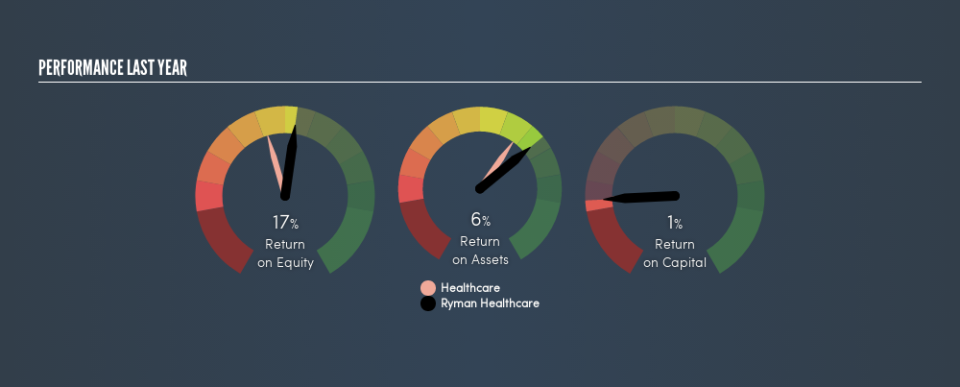Does Ryman Healthcare Limited’s (NZSE:RYM) ROCE Reflect Well On The Business?

Today we’ll evaluate Ryman Healthcare Limited (NZSE:RYM) to determine whether it could have potential as an investment idea. In particular, we’ll consider its Return On Capital Employed (ROCE), as that can give us insight into how profitably the company is able to employ capital in its business.
First of all, we’ll work out how to calculate ROCE. Next, we’ll compare it to others in its industry. Then we’ll determine how its current liabilities are affecting its ROCE.
Return On Capital Employed (ROCE): What is it?
ROCE is a measure of a company’s yearly pre-tax profit (its return), relative to the capital employed in the business. Generally speaking a higher ROCE is better. Ultimately, it is a useful but imperfect metric. Author Edwin Whiting says to be careful when comparing the ROCE of different businesses, since ‘No two businesses are exactly alike.’
How Do You Calculate Return On Capital Employed?
The formula for calculating the return on capital employed is:
Return on Capital Employed = Earnings Before Interest and Tax (EBIT) ÷ (Total Assets – Current Liabilities)
Or for Ryman Healthcare:
0.0086 = NZ$52m ÷ (NZ$6.2b – NZ$120m) (Based on the trailing twelve months to September 2018.)
So, Ryman Healthcare has an ROCE of 0.9%.
Check out our latest analysis for Ryman Healthcare
Does Ryman Healthcare Have A Good ROCE?
When making comparisons between similar businesses, investors may find ROCE useful. We can see Ryman Healthcare’s ROCE is around the 0.9% average reported by the Healthcare industry. Putting aside Ryman Healthcare’s performance relative to its industry, its ROCE in absolute terms is poor – considering the risk of owning stocks compared to government bonds. Readers may wish to look for more rewarding investments.
When considering ROCE, bear in mind that it reflects the past and does not necessarily predict the future. Companies in cyclical industries can be difficult to understand using ROCE, as returns typically look high during boom times, and low during busts. ROCE is, after all, simply a snap shot of a single year. What happens in the future is pretty important for investors, so we have prepared a free report on analyst forecasts for Ryman Healthcare.
What Are Current Liabilities, And How Do They Affect Ryman Healthcare’s ROCE?
Current liabilities include invoices, such as supplier payments, short-term debt, or a tax bill, that need to be paid within 12 months. Due to the way ROCE is calculated, a high level of current liabilities makes a company look as though it has less capital employed, and thus can (sometimes unfairly) boost the ROCE. To counteract this, we check if a company has high current liabilities, relative to its total assets.
Ryman Healthcare has total liabilities of NZ$120m and total assets of NZ$6.2b. As a result, its current liabilities are equal to approximately 1.9% of its total assets. With barely any current liabilities, there is minimal impact on Ryman Healthcare’s admittedly low ROCE.
What We Can Learn From Ryman Healthcare’s ROCE
Nevertheless, there are potentially more attractive companies to invest in. You might be able to find a better buy than Ryman Healthcare. If you want a selection of possible winners, check out this free list of interesting companies that trade on a P/E below 20 (but have proven they can grow earnings).
I will like Ryman Healthcare better if I see some big insider buys. While we wait, check out this free list of growing companies with considerable, recent, insider buying.
We aim to bring you long-term focused research analysis driven by fundamental data. Note that our analysis may not factor in the latest price-sensitive company announcements or qualitative material.
If you spot an error that warrants correction, please contact the editor at editorial-team@simplywallst.com. This article by Simply Wall St is general in nature. It does not constitute a recommendation to buy or sell any stock, and does not take account of your objectives, or your financial situation. Simply Wall St has no position in the stocks mentioned. Thank you for reading.

 Yahoo Finance
Yahoo Finance 
